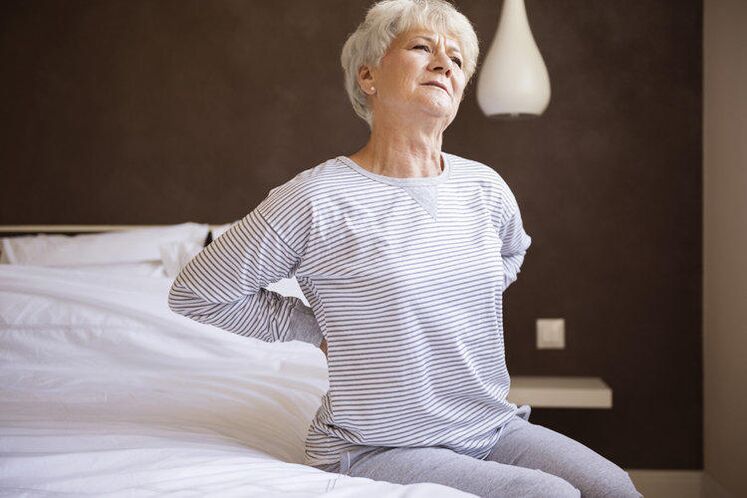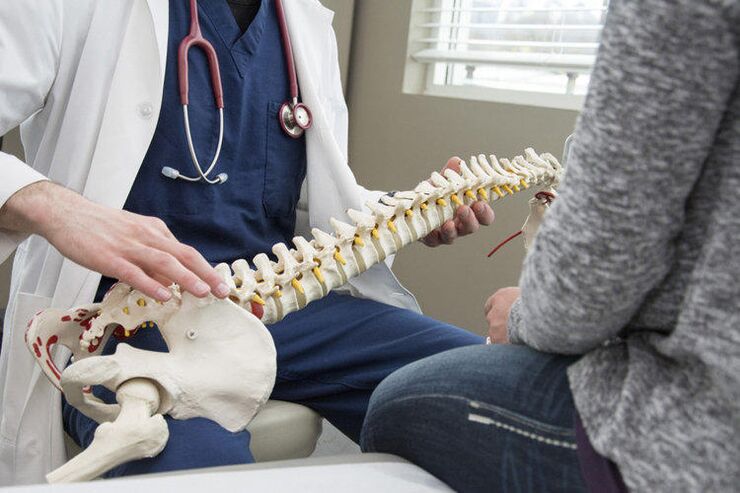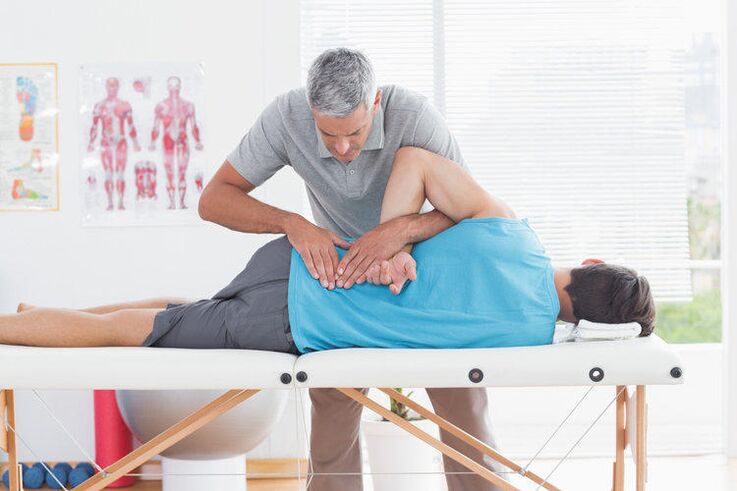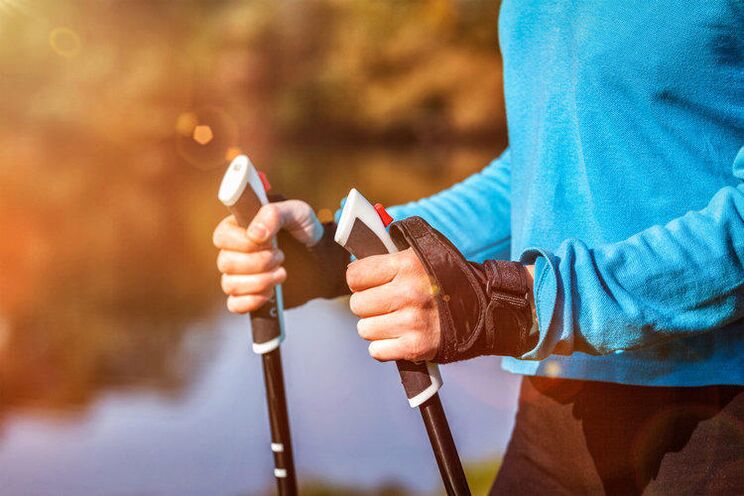Osteochondrosis is a disease in which degenerative-dystrophic changes are diagnosed in spinal cord tissue, also accompanied by structural disorders and function of the intervertebral disc. Depending on the localization of damaged tissue, cervical osteochondrosis, thoracic and lumbar osteochondrosis are distinguished.

What is osteochondrosis?
Osteochondrosis is a spinal column disease in which degenerative lesions and dystrophic intervertebral disc occurs. With the development of osteochondrosis, degenerative-dystrophic lesions are applied to vertebral tissue.
The main features that show the development of osteochondrosis are pain in the neck, back, lower back, with development, pain "gives" into the hands, chest, shoulders, upper thighs, and others with negative dynamics of osteochondrosis, muscle tissue atrophy, impaired sensitivity, and disfocolation. Transfer. In the absence of timely therapy, osteochondrosis develops into incurable conditions.
The cause of osteochondrosis
The main factor in the development of osteochondrosis is the uneven load of the spine. The habit of carrying a bag on one shoulder or in one hand, improper pose in a sitting position, a dream on a soft mattress, a high pillow, wearing an anatomical type of anatomy is a common cause of unnatural distribution.
Additional risk factors include hypodynamia, inactive lifestyle, excess weight, back injuries, lower legs, flat feet and other disorders of the musculoskeletal system, as well as age -related degenerative processes in age -related changes in vertebral column supply.
In the etiology of osteochondrosis, the following factors can also play a role:
- physical overvoltage of the body;
- neuro-emotional fatigue;
- metabolic disorders, poisoning, gastrointestinal tract disease that prevents full nutrient assimilation;
- Professional risks, in particular, work on vibration platforms;
- genetic tendency;
- violations of posture during active growth, scoliosis;
- wear uncomfortable shoes (narrow, heels);
- prolonged and/or normal dehydration;
- low diet, hypovitaminosis;
- smoking;
- Pregnancy, especially diverse, in combination with unbounded muscles (due to the central displacement of the body of gravity).
Stage of development of osteochondrosis
Osteochondrosis in dynamic disease past four stages:

- Stage 1 osteochondrosis (degree) is characterized by an early stage of pathology in the nucleus pulpos of the intervertebral disc. Due to excessive load, the process of dehydration (dehydration) of the nucleus begins, resulting in a decrease in disc height parameters and cracks in the fibrous ring. Symptoms at this stage are usually absent, small discomfort may occur with prolonged accommodation in uncomfortable statical pose, active movement, and more;
- In 2 stages, the decrease of disc height causes a decrease in the distance between the vertebral and the sagging of the vertebrate and the ligaments. This causes an increase in vertebral mobility with the affected disc, which is dangerous with displacement or slipping. In the second stage of the disease, discomfort, pain occurs, mainly with several types of load, movement, position;
- 3 -stage osteochondrosis (degrees) is characterized by the formation of prolapses and intervertebral disc protrusions, can be accompanied by subluxis and/or development of intervertebral joint arthrosis. With some kind of movement, the patient feels stiffness, insufficient mobility, feeling of tingling, numbness may occur in the limbs. At this stage, osteochondrosis is clearly felt on the back, neck, lumbosacral or coccyx department, depending on the localization of the affected disc;
- In 4 stages of osteochondrosis, the body tries to adjust the effects of vertebral hypermobility and adapt to the impaired function of the spinal column. Osteophytes, a new bone formation, which seizes vertebral setting is formed in places of vertebrae touch. However, in some cases, osteophytes can cause nerve infringement, injuring the vertebra. Fibrous ankylosis begins on the intervertebral disc and joints. In the absence of microtrauma and nerve root infarction, symptoms of the disease subside.
Symptoms of osteochondrosis
The main symptoms of osteochondrosis are the feeling of discomfort and/or pain in the neck, back. Sensation severity and the presence of additional symptoms depend on the level of the disease. When examining the patient and collecting anamnesis, the specialist conducts an initial diagnosis, assuming the presence of osteochondrosis with a visual -determined curvature observed in the horizontal or longitudinal plane of the vertebral column. The pathology of the cervical and lumbar intervertebral disc is found to be more frequent than degenerative and dystrophic changes in the sternum area.
The signs of osteochondrosis, which the patient feels, includes periodic or permanent fatigue, extinguished or pronounced, depending on the level of the disease, pain. Pain can be localized in the neck, back, chest, shoulder belt, complicates, emits the movement of the upper limbs.
The clinical picture of osteochondrosis largely depends on the localization of the pathology, the level of development of the process, the individual characteristics of the patient. Pathology of intervertebral disc, displacement, highlights, hernia and increased osteophytes lead to a variety of consequences. Among the most common, infringement of normal blood circulation in tissues, pinching nerve endings, spinal duct dysfunction, edema, tissue fibrosis and structure are distinguished.
Such consequences can be accompanied by many different symptoms, leading to the diagnosis of the wrong disease.
The most common symptoms of osteochondrosis and features include the following:
- pain in the back, neck, lower back, shoulder tie, rib area;
- discomfort, stiffness of body movements that occur in some body position, tendency, turn, increased muscle tension;
- feeling numb from the top and bottom;
- muscle and joint discomfort, muscle cramps;
- headache, dizziness, increased fatigue;
- pain in the heart;
- violations of hand sensitivity;
- Muscle hypotension.
Symptoms of osteochondrosis vary depending on the localization of the pathology:
- with cervical spinal osteochondrosis, neck pain, hands, shoulder straps, radiating to the shoulder and shoulders; headache, dizziness, "flies" or places in front of the eyes, noise in the ear is observed;
- With damage to the thoracic spine, the pain is localized in the chest area, heart, the internal surface of the shoulder, the armpit area, the discomfort of the respiratory is also observed, shortness of breath;
- Lumbosacral spinal osteochondrosis is characterized by pain in the lower back with irradiation to the legs, upper thighs or pelvic organs, sexual dysfunction is often accompanied.
The shallow symptoms - back fatigue, pain - can indicate not only the presence of osteochondrosis, but also the addition of other diseases or the development of pathological processes and other disorders not associated with the intervertebral disc dys. Diagnosis of osteochondrosis can only be made by a specialist, and the medication of the symptoms with the symptoms is unacceptable.
Diagnosis of osteochondrosis

To make a diagnosis, the instrumental examination method is used:
- X -Ray Spinal Department Examination;
- myelography;
- Neurological studies of sensitivity, reflexes.
Additional methods set for differentiation and diagnosis, pathological levels include:
- Tomography calculated spine (CT);
- nuclear-magnetic resonance (jamr);
- Magnetic resonance imaging (MRI).
Therapy instructions for osteochondrosis
Treatment is based on an integrated approach and, depending on the stage, lasts from 1 to 3 months of intensive treatment and 1 year support steps to unify the results and prevention of relapse.
Osteochondrosis is carried out therapy for two directions depending on the level of osteochondrosis and the patient's health. Conservative treatment of the disease consists of taking medications, doing a set of exercises. Surgical treatment in almost all conditions cannot be the first choice and prescribed in the absence of a positive dynamic, the development of the disease to the background of prolonged conservative therapy.
In addition to medical therapy methods, it is necessary to follow the general suggestions for osteochondrosis: observe the diet, take the steps needed for recovery.
Conservative treatment of osteochondrosis
Conservative therapy aims to stop the pain syndrome, normalize the function of the spinal column and prevention of negative changes
Conservative treatment of osteochondrosis includes the following types of therapy:
- Drug therapy. Medications for osteochondrosis are used to stop pain syndrome, inflammation in the tissue and normalize the body's metabolic processes. With the mentioned pain syndrome, it is recommended to use nerve endings, which also contributes to the decrease in the severity of muscle-tonal syndrome. The following types of restrictions are distinguished: trigger point restrictions, intraosseous, aspects, paravertebral, epidural;
- Physiotherapy method. Physiotherapy procedures help reduce pain, improve medication effects, are also used during the recovery period. The most common use of ultrasound waves, magnetic fields, low frequency current, laser radiation, etc.
- Physiotherapy Training Methods (Training Therapy) and Kinesitherapy. Spice complexes with regular and proper implementation contributes to posture correction, strengthening muscle corsets, ligaments, normalizing muscle function, reducing nerve fiber compression and helping to prevent osteochondrosis complications. Training therapy methods and kinesitherutic procedures are intended to normalize metabolic processes, restore the full nutrition of intervertebral discs, restore vertebral and disc arrangements between them, uniform distribution of loads in the musculoskeletal system;
- Massage. Manual massage techniques are used to increase blood supply to tissues, relieve muscle cramps and clamps, and generally improve blood circulation. Hydromassage as the direction of therapeutic activity in addition to the effects listed contributes to the normalization of the body's nervous system;
- Manual therapy. Manual therapy methods are individually selected. The effect of the point on the musculoskeletal system helps improve blood circulation, lymph circulation, improves metabolism, promotes mobility of the musculoskeletal system, strengthens the immune system, and acts as a way of preventing osteochondrosis complications;
- Therapy with the traction (attractiveness) of the spine uses special equipment. The purpose of manipulation is to increase the intervertebral space to normal parameters, correction of violation of the spinal column structure.
Prevention of osteochondrosis

The causes of osteochondrosis are mainly associated with the absence of attention to the body's needs, lack of nutrients, excessive burden on the body. To prevent the onset of pathological changes in the spine and withstand existing osteochondrosis dynamics, it is recommended to adhere to the general principles of a healthy lifestyle:
- Hypodynamia's possible exceptions: simple sports: charging, running, swimming, bicycles, skiing, gymnastics, types of non -contact struggles, and so on;
- When working or other forms of long -term activities in a static position, it is necessary to take a rest every 45 minutes to restore blood circulation. If necessary, sit for a long time, you should choose the right chair, chair by ensuring spinal support, monitoring compliance with standards for hands on the table, feet on the floor or special stand, familiar with posture (even back, relaxing shoulders);
- For night sleep, it is necessary to choose an elastic orthopedic mattress, preferably with a flat surface, avoid high or too flat pillows;
- If necessary, raise and/or wear heavy objects to avoid screams, lifting the severity of the half -exact position, using a special belt that supports the lower back;
- Proper orthopedic shoe choices: with the same feet as width, without high heels and timely replacement will help reduce the burden on the spine, this is very important for women during childbirth. In the summer, do not neglect the ability to walk barefoot on uneven surfaces, this strengthens the leg muscles and relieves tension from the musculoskeletal system;
- Proper diet, drinking mode contributes to overall health and helps maintain normal metabolism;
- With the tendency to improve emotion, anxiety with muscle spasmodic reactions to stress, it should study the relaxation method.















































